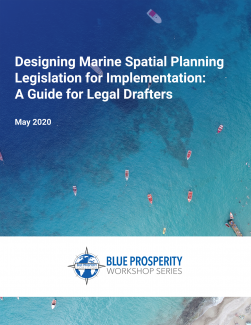How Small-Scale Fisheries Can Become a Huge Success

Nothing about small-scale fisheries is actually small. About 90 percent of the world’s 120 million capture fishers are involved in what we’ll call SSF, making it the world’s largest creator of marine jobs, as well as an economic activity that supports the food security of millions.
As the human population living by or near the coast continues to increase, the role of SSF is becoming even more important. Small-scale fisheries are extremely diverse, ranging from traditional, customary, and indigenous fishing practices to near-shore, semi-industrialized fishing. For the most part, fishers are members of coastal communities, and spend their earnings in the same places they live.
The governance problems affecting the SSF sector are not small either. The most common challenges relate to a lack of financial and legal certainty, training, adequate data to improve management, and commercial know-how, as well as an absence of funding for addressing reforms.
Seeking to provide guidance on how to promote a more sustainable SSF sector, the Food and Agriculture Organization of the United Nations published the “Voluntary Guidelines for Sustainable Small-Scale Fisheries.” This document stresses the close connection among ocean governance, environmental stewardship, and the central role of fisheries for protecting the human rights and economic security of tens of thousands of small-scale fishing communities around the world.
Building on this connection between environmental sustainability and human rights in the SSF context, ELI developed the Small Scale-Fisheries Law and Governance Toolkit, implemented in partnership with Parliamentarians for Global Action, a global network of policymakers focused on promoting human rights.
In many instances, a knowledge gap exists between promoting sustainability practices and implementing these goals on the ground through regulatory procedures. The toolkit bridges this divide by identifying useful regulatory approaches for SSF governance, with a special focus on fisheries co-management, and provides this information in the form of model legal language so that others may review and adapt provisions to the legal framework of a specific country or region.
For this project, ELI draws from its experience reviewing environmental laws around the world for the “First Environmental Rule of Law” report, published in 2019 in partnership with UN Environment. The report found that most laws that promote sustainability struggle with implementation and enforcement. Laws lack clear mandates, insert concepts that are not developed, or introduce policy approaches that are not tailored to the needs and conditions on the ground.
Zooming in on the management of fisheries reveals similar challenges. Many fisheries laws have inserted the concept of “sustainability” without elaborating on how to translate that concept into governance institutions and regulatory procedures. Although a fisheries act may mention, for example, “community participation in governance,” the local community may not know how to exercise that right, and the government agent does not know how to enable that process. This is where legal analysis can prove useful by generating actionable rules and identifiable processes based on research.
The toolkit starts by presenting a methodology for assessing the need for regulatory reforms with a specific lens on the challenges and needs of the SSF community. Given the central role of co-management in sustainable SSF governance, the toolkit focuses on creating and implementing co-management systems, along with two basic governance elements that strengthen them: exclusive fishing rights for SSF communities and the creation of exclusive zones for SSF. Remaining sections address fundamental elements for enhancing the likelihood of success for a sustainable SSF co-management scheme: strengthening compliance, overcoming the conceptual opposition between fisheries and marine protected areas, and making SSF governance compatible with other area-based ocean management approaches.
The ELI team’s goal was to make the model legal language included in the toolkit specific enough to help advance the issue of sustainable governance with detailed models, yet general enough so that the language can be applied to different contexts and legal systems. In other words, the toolkit should help policymakers answer the question, Can my country’s legal framework provide better guidance to achieve these objectives? The resource then provides a few examples on how to operationalize that governance challenge.
How Small-Scale Fisheries Can Become a Huge Success.
ELI Report
Making Law Work Institute guides countries on drafting marine spatial planning legislation with new handbook, implementing ideas
The ocean is significantly altered by human activities, such as fishing, offshore oil and gas development, and plastic use. Future uses such as deep seabed mining have potential to even further affect the marine ecosystem.
As commercial activities in the “blue economy” expand, so too will ocean governance. In order to sustain resources while maintaining long-term growth of economies, countries are increasingly turning to marine spatial planning to manage ocean environments.
MSP allocates the “spatial and temporal distribution of human activities in marine areas,” organizing these different uses to achieve both ecological and economic goals. Although many resources describe how to create a plan, none show how to incorporate MSP into law.
Recognizing this need, ELI, in partnership with Animals | Environment PLLC and under the Blue Prosperity Coalition, published Designing Marine Spatial Planning Legislation for Implementation: A Guide for Legal Drafters in May 2020. The document provides guidance to the busy government lawyer tasked with drafting an MSP law. The guide was followed by a webinar in December and a series of accompanying videos detailing each section of the resource.
The guide draws upon the knowledge and contributions of participants at a 2019 MSP workshop in New Zealand, hosted by ELI in collaboration with the Waitt Institute and IUCN. The four-day event marked the first of a series of workshops by the Blue Prosperity Coalition, a global network of ocean experts working to assist governments in developing MSPs.
Workshop members representing over 16 different countries, primarily from island states in the Pacific region, including Fiji, Niue, Samoa, Tonga, and others, convened to discuss lessons learned and guiding principles for drafting legislation.
Building off these discussions, the guide supports legal drafters from ocean and coastal states where the development of MSP legislation is under consideration. The handbook highlights the essential components and subcomponents of legislation, and explains each feature’s role and significance. It also provides sample text provisions, prepared by the guide’s authors and drawn from existing MSP laws, to address each component. Finally, the guide provides tips for legal drafters. ELI Staff Attorney Sofia O’Connor serves as lead author of the guide.
A follow-up webinar hosted in December was attended by legal drafters, nonprofits, and philanthropy groups. Speakers, including César Toro, head of the Subcommission for the Caribbean and Adjacent Regions of the Intergovernmental Oceanographic Commission of UNESCO, noted the particular significance of planning for island nations that manage ocean territories several hundred times larger than their sovereign land. Maria-Goreti Muavesi, senior environmental legal officer at IUCN Oceania, provided case studies of MSP processes in Pacific Island nations, including Vanuatu, Fiji, and Tonga.
Speakers discussed the importance of understanding a country’s current legal framework to identify gaps and opportunities as well as the need to periodically review plans based on new scientific data and other developments.
This guide marks a significant milestone in ELI’s long-term cooperation with the Waitt Institute on the implementation of MSP, which has included legal assessments in Bermuda, Montserrat, Curacao, and Barbuda. Over more than a decade, ELI has developed a number of publications on MSP and coastal zone management for the Caribbean region, the Pacific, and the United States.
Legal ed course still helping new professionals, but virtually
The 29th Annual Eastern Boot Camp on Environmental Law, ELI’s signature legal education course for environmental professionals, was offered virtually last November. For more than thirty years now, the Eastern Boot Camp has educated new and experienced lawyers, consultants, government officials, and nonprofit and advocacy professionals on the substance and practice of environmental law. The intensive course provides about 20 hours of continuing legal education credits. ELI also offers the Western Boot Camp on Environmental Law, a similar course held on the left coast each spring.
Efforts were of course made to accommodate the unique challenges of hosting a live course online to ensure an optimal experience for both faculty and participants. The program was spread over three consecutive Thursdays, and incorporated more frequent breaks and multiple virtual networking receptions. Brenda Mallory, nominated to be chair of the White House Council on Environmental Quality and an ELI board member, gave opening remarks at the first networking reception, describing her career and trajectory in environmental law. The second networking reception featured Ruth Ann Castro, senior environmental health and safety counsel at Google and ELI board member.
The Eastern Boot Camp holds a reputation as an effective course for preparing professionals beginning or seeking a refresher in the area of environmental law, due in part to its outstanding faculty. Instructors for this year’s National Environmental Policy Act session included leading NEPA experts such as Edward Boling, former associate director at the Council on Environmental Quality, as well as Stacey Bosshardt, former assistant section chief and senior trial attorney in the Justice Department’s Environment and Natural Resources Division.
This year, the timing of the session on environmental justice was extended to reflect growing interest and the need for additional content. Other notable highlights include successful efforts to achieve gender parity within the faculty and participants, and to reflect the diversity of the environmental profession. In the end, the course saw record attendance in its virtual format.
New initiative aims to encourage sustainable growth of high seas
Advances in technology have opened up new possibilities for commercial activities in previously inaccessible areas of the high seas — including shipping, wind and energy development, and marine mining. As a result, concern is growing that these areas beyond national jurisdiction will experience rapid industrialization. The concept of blue growth refers to the expansion of maritime industries and the need to ensure that this new development is conducted in an environmentally sustainable manner.
One way to achieve blue growth is to establish regulatory procedures for ocean industries in the high seas. The Institute’s Blue Growth Law and Governance Initiative, led by ELI Visiting Scholar Patience Whitten and supported by the Leaves of Grass Foundation, was created in August to address these emerging issues and play a leading role in the global discussion on the development of the marine economy.
Whitten, a veteran federal regulator with over twenty years of experience at agencies including EPA and the National Oceanic and Atmospheric Administration, leverages her expertise in environmental impact analyses for large-scale industrial projects and her training in international finance to engage in discussions surrounding blue growth.
In the near term, the initiative will participate in negotiations to develop legal requirements for environmental impact assessments in areas beyond national jurisdiction, part of a larger UN effort known as the BBNJ process. The initiative will also provide input on the next stage of negotiations, when UN members will decide how to operationalize these procedures.
Another area of interest is financing for ocean projects. Recognizing a growing portfolio of economic mechanisms that incorporate social and environmental objectives, the initiative hopes to explore how sustainable financing for high seas projects can influence the environmental outcomes of blue growth.
On a broader level, the initiative seeks to engage both regulators and the regulated community in discussions around sustainable growth. The program intends to not only analyze best practices and contribute to policy outcomes, but also address specific regulatory challenges from the ocean industry community and reflect common interests among a diverse range of stakeholders.
ELI in Action EJ clerkship will support diversity in law profession
In November, ELI and Howard University School of Law announced the formation of the Environmental Justice Clerkship at ELI, a new program designed to train, mentor, and ultimately retain more students of color in environmental law while advancing environmental justice efforts.
Each semester and summer, one Howard law student will work closely with ELI experts on a variety of projects with an emphasis on environmental justice. These may include researching and drafting model bills, assisting overburdened communities with sustainable development planning, and writing reports to support community-driven environmental justice goals. With the support of the True Costs Initiative, each clerk will receive a stipend to ensure that socioeconomic background does not limit the clerkship’s reach.
❧
A considerable number of dry cleaners in the United States use a chemical called perchloroethylene (perc or PCE). PCE releases pose a potential health risk for children and staff at nearby child care facilities. An ELI report titled Federal, State, and Local Policies Addressing Chemical Emissions from Dry Cleaners: Opportunities for Reducing Exposure at Child Care Facilities, released last July, describes some of the laws and regulations that have been established to address this ongoing public health issue. The report discusses air quality regulations, land use and zoning ordinances, and child care licensing regulations. The text supports decisionmakers in developing policies to reduce environmental exposures related to dry cleaners.
❧
Environmental racism refers to the institutional laws and policies that create and perpetuate disproportionate impacts of environmental hazards in marginalized communities. An ELI webinar held in November convened environmental justice experts to discuss opportunities for dismantling environmentally racist practices.
Speaker Carlton Waterhouse, professor of law at Howard University and an ELI Board member, emphasized that white supremacy and racial discrimination are the roots of environmental racial disparities.
Vernice Miller-Travis, executive vice president of Metropolitan Group, highlighted the importance of using both civil rights law and environmental law to guide environmental justice policies and decisionmaking.
Jason Travis Hauter, partner at Akin Gump Strauss Hauer & Feld LLP, described strategies used by American Indian and Alaska Native tribes to address environmental racism. On opportunities for moving forward, Jacqui Patterson, director of the Environmental and Climate Justice Program at the NAACP, emphasized that solutions to environmental racism need to address multiple facets of discrimination, including sexism, ableism, and other forms of oppression.
❧
The Climate Judiciary Project, led in collaboration with the American Association for the Advancement of Science and the Federal Judicial Center, educates judges on the science underpinning arguments in climate cases. Having completed its first year of pilot seminars, the project will now focus on developing an online curriculum that provides recorded lectures and background information on climate science and its application to legal cases.
The curriculum will be composed of 14 different modules prepared by top-tier climate scholars and law experts. An advisory committee of scientists, judges, and legal scholars will provide input on the development of the curriculum. In addition, the project aims to hold a series of live seminars with the judicial community, continuing to expand its efforts to engage judges in discussions around the application of climate science in the law.
❧
In 2019, ELI hosted the inaugural GreenTech Conference in Seattle, convening technology companies, policymakers, young innovators, NGOs, and academia to discuss the future of environmental protection in an era of rapid advances in technology.
This past year, the Institute launched a free, virtual GreenTech webinar series. The first installment, “Digital Solutions to Climate and Water Challenges,” took place in November to discuss how digitizing energy and water services can help reduce the climate and water footprint of sectors like transportation and manufacturing.
Future webinars will explore the environmental applications and implications of artificial intelligence and how tech can support environmental justice and renewable technology.
ELI's New Handbook Guides Marine Spatial Planners
Can UNCLOS Do More for Biodiversity?

Many small countries rely on international law to make progress in domestic policy and regulatory matters. Sometimes it is the easiest way to generate a framework for action when domestic negotiations fail. This is especially true in environmental protection.
For a tiny country such as Ecuador, the relevance of marine resources was imprinted in the early years of the republican era. Following independence, Ecuador annexed the Galapagos Islands. Just a few years later, in 1835, Charles Darwin arrived at the Enchanted Islands.
Due to currents and a volcanic origin, the Galapagos’ marine ecosystem unites unique conditions that create a vast endemism, or restriction to an area, and a high oceanic biodiversity at the same time. Since 1979 the islands have been one of the world´s protected natural heritage sites under UNESCO. Ecuador ratified the Convention on Biological Diversity in 1995, and three years later formally established the Galapagos Archipelago as a national protected area with a special regime.
In 2012, Ecuador ratified the UN Convention on the Law of the Sea. Following accession to UNCLOS, the country began to abide by the 12 miles of territorial sea and the 188 miles of Exclusive Economic Zone beyond that. With that, the possibility arose to take advantage of the fish resources found therein but also to exercise Ecuador’s duty regarding the management and protection of marine biodiversity within the jurisdiction of 200 miles. But, is that distance enough to protect such a sensitive ecosystem?
That question was raised recently by the presence of more than 260 Chinese-flagged large industrial fishing vessels carrying out operations in the limits of the Galapagos marine reserve. This raises once again the issue of the current difficulties faced by the parties of several multilateral environmental agreements in protecting their marine ecosystems under the current status of international law and its various provisions and agreements.
The case of the Galapagos Archipelago is confusing. There is a non-jurisdictional area allowing intensive exploitation, including foreign industrial fishing, and permitting the capture of threatened migratory species that transit back and forth between the unprotected areas and the archipelago’s reserve. This has allowed some national and international organizations to wonder about how UNCLOS can help guard sensitive marine areas protected by other multilateral agreements.
UNCLOS distinguishes between two geographical zones in what are termed Areas Beyond National Jurisdition. They are called the Area and the high seas. The Area is defined as “the seabed and ocean floor, and subsoil thereof, beyond the limits of national jurisdiction.” The Area and its mineral resources are considered the “common heritage of mankind.” All this, bearing in mind that activities in the Area must be conducted “for the benefit of mankind, irrespective of the geographical location of states.”
Acting under UNCLOS Article 76, which regulates exclusive rights on the continental shelf, recently Ecuador and Costa Rica filed a binational document before the UN Commission on the Limits of the Continental Shelf. The purpose was to establish sovereignty over adjacent continental shelf beyond our jurisdictions. This in turn would create a binational marine corridor that can connect the Galapagos Archipelago with Isla de Cocos in Costa Rica. Numerous studies have determined that many protected marine mammals, sharks, and other migratory species cover that route regularly.
It is well known that UNCLOS establishes the rights and obligations of states regarding the use of the oceans, their resources, and the protection of the marine and coastal environment. Nevertheless, it does not expressly refer to marine biodiversity within the water column in areas beyond national jurisdiction.
However, UNCLOS does declare important environmental duties that should be taken into consideration to support initiatives such as the one Ecuador and Costa Rica are proposing. These duties arise from considering that both the high seas and the Area should be subject to obligations to conserve and manage the living resources and the marine environment. States are already obligated to prevent, reduce, and control pollution of the marine environment. They must take the measures necessary to protect and preserve rare or pristine or fragile ecosystems as well as the habitat of depleted, threatened, or endangered species. Moreover, it is the duty of all states to cooperate with other states, both at the regional and global levels
In order to improve marine governance, it is crucial that UNCLOS supports other multilateral environmental agreements, such as the Biodiversity Convention in the Galapagos context. Ecuador must also push to strengthen the Food and Agricultural Organization, regional agreements on fishery management, and International Maritime Organization conventions.
Then states can protect endangered species that don’t spend all their time in protected areas with a new intergovernmental framework. The purpose is to limit illegal, unregulated, and unreported fisheries that threaten protected marine ecosystems in high seas adjacent to the limit of national protection, zones where countries are executing ecosystem-protection and conservation measures. After all, protecting marine ecosystems and their biodiversity is a means toward conserving the common heritage of mankind.
For Shipping, Be Careful What You Wish For

Shipping is a global industry requiring global rules. Otherwise there would be chaos. From the perspective of shipowners, who collectively transport about 90 percent of global trade, the UN Convention on the Law of the Sea is eminently fit for purpose.
But in response to the degradation of the sea by other human activities, a diplomatic conference has been convened by the United Nations, with a final session expected this year. The objective is to adopt a new global agreement to allow, within the framework of UNCLOS, the development of regulations to protect biodiversity in sea areas beyond national jurisdiction — environmental regulation that can be enforced on the high seas.
Unlike most other ocean activities, however, the shipping industry is not operating in a regulatory vacuum. If a ship sails from Baltimore to Buenos Aires, the same rules already apply at both ends of the voyage and on the ocean in between. As with regulations governing safe navigation, for example, there are already global rules, with a robust system of enforcement, governing virtually every aspect of a ship’s environmental performance.
This is because, within this framework under UNCLOS, shipping is comprehensively regulated by the International Maritime Organization, the specialized UN agency, based in London, whose authority is derived from UNCLOS and its predecessors.
Over the past 60 years, a highly successful system to ensure maritime safety and pollution prevention, comprising over 50 diplomatic conventions and protocols, has been developed by the world’s governments under IMO’s auspices. Although the United States may not yet have ratified UNCLOS, Washington has acceded to the vast majority of these IMO instruments and takes an active role in all their discussions.
There are around 80,000 commercial ships engaged in international trade, which must all adhere to IMO regulations throughout each and every voyage. Importantly, this includes strict adherence to the International Convention for the Prevention of Pollution From Ships, known as the MARPOL Convention, which enjoys almost universal ratification worldwide (including the United States) and addresses just about every potential environmental impact from commercial shipping.
The IMO regulatory system, within the framework of UNCLOS, thus already successfully ensures that a ship’s activities are never beyond the national jurisdiction of its flag state, even when the vessel is operating on the high seas beyond the territorial waters or Exclusive Economic Zones of coastal states.
As well as being overseen by a rigorous system of flag-state enforcement, compliance with IMO regulations is also subject to oversight by a sophisticated regime of port state control inspection, coordinated via regional agreements within the global IMO framework.
As a consequence of this impressive IMO regime, the number of serious oil spills is a fraction of what it was at the time of the Exxon Valdez disaster — about two per year (comprising over 700 tonnes) during the past decade compared to about 40 in the 1980s, despite a tripling of maritime trade in the same period.
Noting that climate change presents the greatest threat to the ocean, the principal focus of IMO’s current environmental protection agenda is its ambitious strategy to eradicate CO2 emissions from shipping completely, signed-up to by virtually all of the world’s governments (with the current exception of the United States).
MARPOL already includes binding regulations to reduce CO2emissions from ships. These were the first ever to be adopted globally for a single industrial sector, it having been recognized by the UN Framework Convention on Climate Change that CO2 emissions from shipping cannot be attributed to national economies, and that the mandate for addressing these should sit with the IMO.
Assisted by new carbon efficiency standards mandated by MARPOL, the global fleet today emits about 30 percent less CO2 per tonne of cargo transported one nautical mile than it did as recently as 2008. Moreover, within the framework of MARPOL, IMO is now discussing a radical proposal from th e industry to establish a $5 billion global fund, to be financed by mandatory contributions from shipowners, to accelerate research and development of zero-carbon technologies such as hydrogen to enable shipping to decarbonize completely.
However, regulatory arrangements for other ocean industries — such as fishing and seabed mining — are not so well developed as those enjoyed by shipping. And this potentially presents a threat to the regime provided by the IMO.
The final session of the UN session to address the regulation of the high seas within UNCLOS has been delayed due to COVID-19. But in discussion with governments, including the United States, it will be vital to ensure there will be no unintended consequences, particularly with respect to implications for the continuing authority of IMO and its very effective system for regulating the environment impacts of international shipping.
A Forward-Looking Promise — Yet Unfulfilled

As a unique, natural resource-focused international treaty, UNCLOS has a key role in the advancement of rule of law at sea. However, much of its forward-looking promise remains unfulfilled. Thinking about UNCLOS, one tends to focus on its more evident consequence: the assertion of national jurisdiction over large swaths of ocean and seabed. Over the decades after the convention’s entry into force, coastal countries have enacted a plethora of statutes declaring spaces of maritime jurisdiction and entered into hundreds of maritime-boundary agreements.
But next to the UNCLOS provisions on the allocation of maritime space, there are a number of equally relevant provisions on international cooperation for conservation that have not enjoyed the same level of domestic-level development. Today’s vulnerability of our shared ocean is not as much a failure of the UNCLOS text but an observation of what countries have done to implement it.
As we swiftly enter into a new time of unprecedented ocean industrialization, countries should re-invigorate efforts to secure adequate implementation of UNCLOS on, among others, the following three areas: securing environmental conservation, achieving cross-boundary ocean management, and ending pirate fishing.
UNCLOS declared an unequivocal mandate on the conservation of living marine resources, requiring countries to cooperate to protect the marine environment, and to conserve and manage living resources in the high seas. The UN Fish Stocks Agreement reinforced this approach with additional conservation measures. It introduced the concepts of precautionary and ecosystem management, calling for the establishment of conservation and management measures to maintain or restore marine species. Fishing nations and coastal states have focused on the creation of regional fisheries management organizations for key commercially valuable species like tuna.
Cooperation seems to have focused mostly on the management of key species and not so much on securing ways of cooperating for the protection of the marine environment. The current process for the development of a legally binding treaty for the conservation and sustainable use of marine biodiversity in Areas Beyond National Jurisdiction will open the door for expanding the implementation of the convention’s promise of ocean conservation.
At the same time, although UNCLOS focuses on one shared natural resource (the ocean), the regulatory response has been extremely fragmented. Cross-boundary management of marine resources, and a much more detailed integration of ocean connectivity from the governance standpoint, should be a main focus of ocean governance in the coming years.
In the same way countries have agreements to clarify jurisdiction, they should also have specific legal procedures for cooperation on issues that need a coordinated response. These include harmonized rules for cross-boundary assessments of key commercial species and shared stocks, endangered migratory species, marine protected areas, marine litter and coastal pollution, and environmental impact assessments for ocean-related projects.
Most of these cross-boundary challenges demand a high level of governance coordination that, for the most part, is missing. Fulfilling the mandate of ocean conservation means achieving better integration of ocean governance approaches and regulatory frameworks across jurisdictions. Now the reality of climate change complicates things further and constitutes yet a more pressing call for cross-boundary management of ocean resources. In addition to other benefits, the harmonization of ocean governance frameworks would help seafaring industries with achieving regulatory compliance. I hope that innovative and targeted legal research, such as ELI’s Regulating Blue Growth project, will be useful to provide some guidance in this process.
Finally, updating the way some elements of UNCLOS are interpreted and implemented could reinforce actions to eliminate illegal, unreported, and unregulated fishing. One of them concerns the interpretation of UNCLOS Article 111 on the right of hot pursuit. These requirements should be interpreted in a way that takes full advantage of the use of 21st century technology.
Coastal countries can adopt provisions that allow for the use of remote monitoring to fulfill the requirements of legal hot pursuit. International agreements such as the Australia-France Agreement on Cooperative Enforcement of Fisheries Law encourage a more updated, flexible interpretation of the concept of hot pursuit by enabling its exercise through the use of “technical means.” The broad concept of technical means allows the coastal states to use vessel tracking devices or satellite imagery as valid instruments to ensure the uninterrupted pursuit of foreign vessels, and to gather evidence of their illegal actions.
As more states see the economic and human security of thousands of fisheries-dependent communities threatened by pirate fishing, coastal countries could develop regulations to limit the access of illegal fishing vessels to their waters by developing the provisions of UNCLOS Articles 21 and 22, which allow the coastal state to limit the right of innocent passage due to a series of national security concerns.
Environmental Protection's Biggest Act Yet?

The state of Earth’s marine environment continues to face an array of threats ranging from pollution from land-based sources to overfishing to climate change. Some 60 percent of the world’s major oceanic ecosystems have been degraded or are being used unsustainably. This imposes welfare costs on current and future generations. A growing awareness of the problems has put the conservation and sustainable use of the marine environment firmly on the international agenda. In this context, marine protected areas have been receiving increasing attention from policymakers as an instrument to achieve that goal.
Indeed, MPAs have been turning into a coherent global conservation strategy. The first key event was in the text of the UN Convention on the Law of the Sea, which in 1982 declared that the idea behind terrestrial protected areas could be applied to the continental shelf. While UNCLOS established general obligations to safeguard the marine environment, arguably it also created a legal obligation for states to create MPAs.
In 1992 the Rio Earth Summit established the Convention on Biological Diversity. Target 1.1 calls for “at least 10 percent of each of the world’s ecological regions [to be] effectively conserved.” In 2010, the CBD reported that not only had the area target not been met, but that there was also worrying evidence of a continuing decline of various marine habitats. The strategic plan of the CBD revisited the 10 percent target, establishing that by 2020 at least 10 percent of the world’s coastal and marine areas should be conserved through “effectively and equitably managed, ecologically representative and well connected systems of protected areas and other effective area-based conservation measures.”
The 2030 Agenda for Sustainable Development, adopted by all UN members in 2015, also addresses marine ecosystems in its Sustainable Development Goals. Target 14.5, for example, states: “By 2020, conserve at least 10 percent of coastal and marine areas, consistent with national and international law and based on the best available scientific information.” The omission of a reference to “effective management” in Target 11 can be seen as a reflection that some saw the initial target as too ambitious and also the general tension between achieving both conservation and exploitation goals.
Interest in MPAs as a management instrument has increased, with more than 18,416 in place across the globe. According to the World Database on Protected Areas they cover about 7.6 percent of the ocean area but with substantial variation in coverage between different regions and, more importantly, their effectiveness and ecological representativeness.
While some progress has therefore been achieved toward meeting the CBD target for MPAs, considerably more needs to be done.
The urgency of the threats to the Southern Ocean and the need for protection has never been more critical. The Southern Ocean is one of the least altered marine ecosystems on Earth, and it is home to more than 8,100 unique and diverse species. In 2009, the Commission for the Conservation of Antarctic Marine Living Resources pledged to establish a network of MPAs by 2012.
MPAs account for about 4.6 percent of the CCAMLR area, with the Ross Sea being the world’s largest international MPA. Three further MPA proposals are currently being considered. These are the East Antarctic MPA, originally submitted by Australia and the EU and its member states in 2012, with Norway and Uruguay joining as co-proponents in 2020; the Weddell Sea MPA, which would become the world’s largest, officially submitted by the EU and its member states in 2016, joined by Norway in 2019 and by Australia and Uruguay in 2020; and the Antarctic Peninsula MPA, proposed by Argentina and Chile in 2018.
Although there is widespread support for the proposals, China and Russia continue to block progress. Attempts by the EU and the co-proponents to engage Moscow and Beijing in meaningful discussion have so far not yielded tangible results.
Global targets call for protected areas to be ecologically representative. With the addition of these proposed MPAs, roughly three-quarters of the benthic ecoregions and almost all pelagic clusters would be represented as 10 percent protected.
Discussion will continue this year. And as the European Commission president declared in her 2020 State of the Union address, the EU will use its diplomatic strength and economic clout to broker an agreement to designate MPAs in Antarctica, as this would represent one of the biggest acts of environmental protection in history. Negotiations will no doubt be difficult and will require finding the right balance between conservation and exploitation. Without diluting the conservation objective of MPAs, there may be need for these to be zoned into multiple-use and strictly protected areas.
Need To Address Instability in the Balancing Act

The primary objective of the Law of the Sea Convention is to codify a careful balance. On one side is coastal state sovereignty, sovereign rights, and jurisdiction in their maritime zones. On the other are the flag-state rights and duties in such zones, such as the rights of innocent passage through territorial seas and the freedom or right to fish in the high seas.
The negotiators of the convention at UNCLOS III — the third meeting of the parties under UN auspices — were addressing the tension of the over-exploitation of fish and seabed minerals through recognition of a new 200 nautical mile Exclusive Economic Zone, and new provisions regarding the marine environment, fisheries in the high seas, and seabed minerals in the regulated area. Unfortunately, the economic importance of commercial fisheries, particularly in the high seas, has continued to trump concerns about marine conservation.
My organization works on two existential threats to the ocean: acidification and plastic pollution. Neither of these is specifically mentioned in the convention. The treaty does not itself provide for the details for taking the collective action needed for a significant reduction in CO2 emissions leading to higher pH levels and of plastic that enters waterways. Why? Because the convention is more akin to a “Constitution for Ocean Governance” that sets out rights and duties that nations respect in negotiating more specific agreements. Unfortunately, these threats are growing concurrently with the ocean-harming effects of climate change, which is also not mentioned in the treaty text. To articulate solutions for a coordinated approach, we need new stand-alone agreements, or the incorporation of ocean acidification and plastic pollution into existing instruments.
I would argue that the sea treaty recognizes the legal duty of states to address these threats. This convention framework identifies the duties and responsibilities of conservation in managing living marine resources — and thus the protection of the integrity of the ocean environment — and establishes an expectation for national, regional, and international action and cooperation. As such, looking back we can see it was visionary, even if limited to the knowledge of the time — because we now know the ocean is not too big to fail, that its health is adversely affected by anthropogenic impacts, and those activities continue to reduce its abundance.
Like climate change, ocean acidification is caused by humanity’s carbon dioxide emissions, a third of which have been absorbed by the ocean over the past century. The resulting change in marine chemistry adversely affects every part of the food web, and thus both ocean productivity and its capacity to produce life-giving oxygen.
Plastic pollution is ubiquitous in the global ocean — from its deepest depths to the salt spray from the waves, as well as on every beach, and in every coastal marsh and mangrove forest. Microplastic has been found in virtually all forms of sea life. The threat posed by plastic to the integrity of the ocean has been established, as has the threat to the economic and social well-being of coastal communities.
In regard to international agreements, progress on plastic is much more advanced than ocean acidification. The 1972 London Dumping Convention prohibits the discharge of plastics (and other synthetic material) that will persist in the environment. Annex V of the International Convention for the Prevention of Pollution From Ships, or MARPOL, prohibits the discharge of all plastics into the ocean. These two instruments help get at the 10-20 percent of plastic in the ocean that comes from ships, but not the 80 percent that may be outside the scope of the ocean convention.
We have seen that action can be taken quickly when needed, as in the January amendment to the Basel Convention. The amendment governs the transboundary movement of plastic waste as a means of making the global trade in the material more transparent, and better regulated in regard to safety, human health, and the environment. It also recognizes the need for assisting developing nations, especially Small Island Developing States, from the effects of such plastic pollution.
The advent of a formal proposal for a global agreement to address the full lifecycle of plastic and prevent marine litter and microplastics pollution similar to the Paris climate agreement is supported by two-thirds of UN members, and is thus perhaps inevitable.
Ocean acidification may not be directly addressed under the existing climate change measures of the UN climate convention, the Kyoto Protocol, or the Paris Agreement. However, the 2019 Intergovernmental Panel on Climate Change report on the ocean and the cryosphere made the case for doing so. The Ocean Foundation and its partners have taken the lead on the development of legal and policy measures to address acidification at the subnational, national, and regional level. It is just a matter of time before this is inserted into existing instruments. Or, if it turns out we can articulate why a separate accord would be necessary and appropriate, or perhaps easier, the policy work could become a separate accord on ocean acidification.
Fortunately, the Law of the Sea Convention provides a strong legal foundation to address excess CO2 emissions and plastic as pollution to be prevented. The continuing strength of the treaty lies in its prioritization of the well-being of the global ocean. Thus, it provides the basis and framework for addressing future issues of concern that we have not yet envisioned.
The Debate: Time for the United States to Sign the Law of the Sea Treaty?

The United States is not a party to the UN Convention on the Law of the Sea, a treaty it rejected in 1982 after having taken a key role in the years of negotiations leading up to a consensus text. In the nearly four decades since, the accord has been agreed to by most nations and has become customary international law, in many ways obligating or restricting the United States despite its outsider status.
This Debate addresses implementation of the UNCLOS accord’s environmental and natural resource provisions. It takes place 40 years after the incoming Reagan administration in March 1981 tipped its hand over that language by abruptly dismissing the U.S. delegation to the treaty talks. Elliott Richardson, the former attorney general famously fired by President Nixon and recently head of the American UNCLOS team, called the episode “a second Saturday Night Massacre.”
The new White House was bothered by provisions designating the seabed in Areas Beyond National Jurisdiction “the common heritage of mankind” and providing for an international Enterprise that was to mine the deep ocean bottom and funnel proceeds to parties. Reagan wanted to better secure rights of private U.S. firms to the resources.
With another new administration taking over, joining this critical worldwide accord would help the U.S. ensure rights of passage for military and commercial vessels under the U.S. flag, rights for private parties to mine the seabed — and achievement of the convention’s natural resources and environmenntal mandates that would benefit all Americans. Ongoing talks and possible action on UNCLOS could also open the door to achieving the goals of related treaties like the Biodiversity Convention and the Basel Convention on ocean dumping.
Meanwhile, the ocean faces worsening threats, including acidification and temperature changes due to greenhouse gas emissions, overfishing and biodiversity collapse, and an increasing load of pollution.
The United States is not a party to the UN Convention on the Law of the Sea, a treaty it rejected in 1982. This Debate addresses implementation of the accord’s environmental and natural resource provisions, which caused the U.S. pullout. With another new administration taking over and possibly signing the treaty, UNCLOS, led by Washington, could help to secure benefits for all Americans while helping the oceans overcome climate change, pollution threats, and biodiversity collapse.
Designing Marine Spatial Planning Legislation for Implementation: A Guide for Legal Drafters

Ocean and coastal states around the world are increasingly seeking to better utilize and benefit from their ocean environments, which can be vast in comparison to their land areas. Conflicting human uses, a changing climate, and a desire to ensure long-term sustainability compound the challenge to grow a robust “blue economy.” Consequently, countries are turning to marine spatial planning as a comprehensive management tool to assess and organize present uses of their ocean environments and map for future uses.